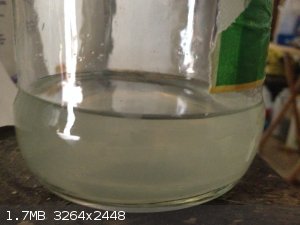
dactyl - 18-12-2016 at 22:27
Hello
I made dioxane by the dehydration of ethylene glycol and sulfuric acid. This dioxane was distilled in separate portions (due to the use of a smaller
distillation apparatus).
The combined crude dioxane was swirled in sodium hydroxide for 12 hours. Then the dioxane was decanted and distilled in separate portions with all of
the portions combined.
At this point I noticed that the dioxane was cloudy and I decided to redistill it. During observation I noticed that at first the distillate appeared
clear but then as the distillation progressed, the turbidity returned.
I took a sample of the dioxane and allowed it to evaportate and I noticed no residue.
Thus,
Is this dioxane too impure for solvent use?
Is there any way to remove the cloudiness?
What is the cloudy substance (if it is one)?

Tsjerk - 18-12-2016 at 23:39
How miscible are water and dioxane?
dactyl - 18-12-2016 at 23:52
If I remember very miscible
UC235 - 19-12-2016 at 03:40
Dump more NaOH pellets in it. I find at least two hefty portions are needed to dry it and it should be allowed to stand over the solid for some time
to remove free acetaldehyde.
Dioxane is a pain in the ass, because manufacture from ethylene glycol produces a decent amount of 2-methyl-1,3-dioxolane (acetaldehyde ethylene
glycol acetal) as well as free acetaldehyde. The dioxolane is totally resistant to treatment with base but isn't stable to acid. It's boiling point is
too close to dioxane to effectively fractionate out, so purification requires alternating base and acid treatment
dactyl - 19-12-2016 at 07:55
After this would redistillation be necessary?
Tsjerk - 19-12-2016 at 23:50
I guess both NaOH and most acids will dissolve pretty well, so I think distillation will be necessary
Update
dactyl - 12-2-2017 at 19:03
The dioxane was subjected to a heaping amount of NaOH and was stirred for several hours and was left as is for several days.
Then, the dioxane was decanted and cold sulfuric acid was slowly added which resulted in a vigorous reaction. Thereafter, a separatory funnel of the
cold sulfuric acid was set up and the acid was allowed to drip at a rate of 1 drop per 3-5 minutes. The next morning the sulfuric acid/dioxane mixture
was allowed to stay together in a closed container for a few days. This mixture froze on the second day, I think, and was allowed to warm up.
Afterward, more sulfuric acid was added and this mixture was allowed to stand and was put back in the cold garage. Days later the H2SO4/ dioxane was
placed in a 1L round bottom flask and set for distillation. The temp did not exceed 120 C. The received distillate was turbid and white, much so than
before and the 1L flask had much black residue. Later the dioxane was distilled in a retort at a low temperature likely lower than the boiling point
of dioxane. After 3 1/2 hours the dioxane distillation was complete and was less turbid. The retort had much less black residue. The dioxane was
allowed to stand for a few days and became less turbid but with floating particles which I believe came from the jar.
Essentially after distillation from NaOH and H2SO4 treatment and a second distillation the mixture remains turbid though much less so on the second
round.
Could it be due to using 100% ethylene glycol straight from the antifreeze?
